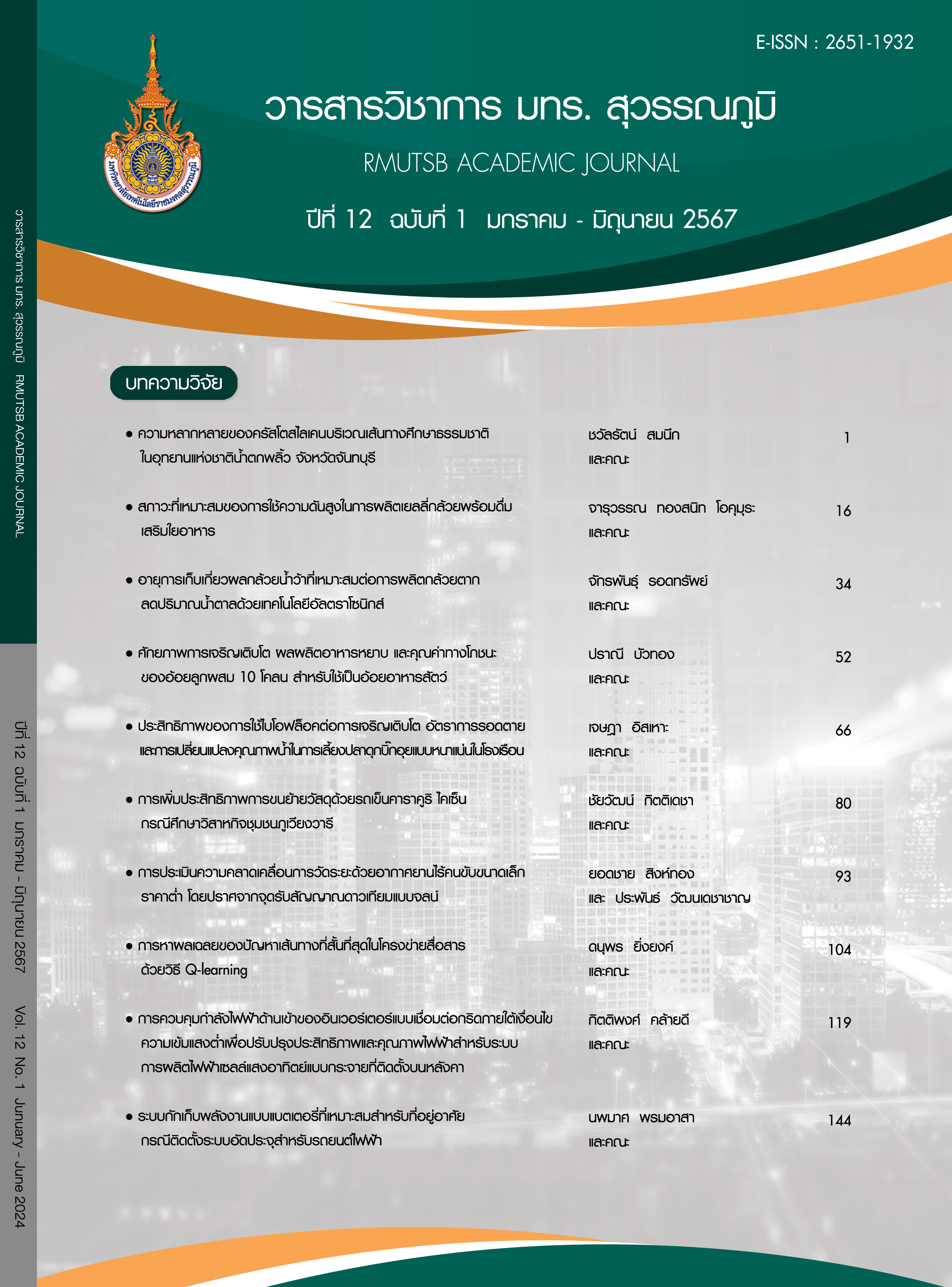Appropriate harvest date of Nam Wah banana on the production of reduced sugar solar dried banana using ultrasonic technology
Main Article Content
Abstract
The ripening stage of bananas resulted in high sugar content in solar-dried bananas. Utilizing early-harvested bananas as raw materials and applying ultrasonic technology for porous in plant tissue may be an approach in the development of reduced-sugar solar-dried banana products. This research aims to produce reduced-sugar solar-dried bananas by comparing three banana harvest ages and applying ultrasonic treatment to fresh bananas before drying at frequencies of 40, 80, 135, and 200 KHz for 30 or 60 seconds. It was determined that bananas harvested at 110 days after flowering (DAF) were found to be suit for solar-dried banana production, exhibiting a Brix/acid ratio of 787.87, total soluble solids (TSS) of 26.0ºBrix, malic acid of 0.033%, reducing sugar of 136.05 mg/g, and non-reducing sugar of 27.30 mg/g, respectively. Samples subjected to 30 seconds of four ultrasonic treatments showed reductions in the concentration of TSS, reducing sugar, and non-reducing sugar ranging from 13.89% to 15.28%, 10.30% to 25.29%, and 27.47% to 46.96%, respectively. Furthermore, samples performed with 60 seconds of ultrasonic treatment showed significantly greater decreases in reducing sugar (19.69% to 30.32%) and non-reducing sugar (42.97% to 56.59%) compared to samples dried using the conventional method. It was also found that subjecting fresh bananas to ultrasonic treatment before drying could reduce the hardness of solar-dried bananas. These findings indicate the potential application of ultrasonic technology in the production of reduced-sugar solar-dried bananas.
Article Details

This work is licensed under a Creative Commons Attribution-NonCommercial-NoDerivatives 4.0 International License.
Published manuscript are the rights of their original owners and RMUTSB Academic Journal. The manuscript content belongs to the authors' idea, it is not the opinion of the journal's committee and not the responsibility of Rajamangala University of Technology Suvarnabhumi
References
AOAC. (2019). Official method of analytical (21th ed.). Gaithersburg, MD: AOAC International.
Baini, R., & Langrish, T. A. G. (2009). Assessment of colour development in dried bananas – measurements and implications for modeling. Journal of Food Engineering, 93, 177-182.
Bhargava, N., Mor, R. S., Kumar, K., & Sharanagat, V. S. (2021). Advances in application of ultrasound in food processing: A review. Ultrasonics – Sonochemistry, 70, 105293.
Boudhrioua, N. M., Michonand, C., Cuvelier, G., & Bonazzi, C. (2002). Influence of ripeness and air temperature on changes in banana texture during drying. Journal of Food Engineering, 55(2), 115-121.
Department of Industrial Promotion. (2009). Test the dried banana market. Retrieved 21 March 2010, from http://www.ssmwiki.org/index.php
De Gennaro, L., Cavella, S., Romano, R., & Masi, P. (1999). The use of ultrasound in food technology I: inactivation of peroxidase by thermosonication. Journal of Food Engineering, 39(4), 401-407.
Division of Nutrition. (1987). The table shows the value of Thai food in the edible portion of 100 grams. Bangkok: Department of Health.
Downes, F. P., & Ito, K. A. (2001). Compendium of methods for the microbiological examination of foods (4th ed.). Washington D.C.: American Public Health Association.
Kerddonfag, P. (2001). Influence of honey drying conditions and effective retention on the browning of baked bananas (Master’s thesis). Kasetsart University, Bangkok.
Lubawy, M., & Formanowicz, D. (2023). High-fructose diet–induced hyperuricemia accompanying metabolic syndrome–mechanisms and dietary therapy proposals. International Journal of Environmental Research and Public Health, 20(4), 3596.
Mason, T. J. (1998). Power ultrasound in food processing – the way forward. In M. J. W. Povey, & T. J. Mason (Eds.), Ultrasound in food processing (pp. 105-126). London: Blackie Academic & Professional.
Mizrach, A., Galili, N., & Rosenhouse, G. (1994). Determining quality of fresh products by ultrasonic excitation. Food Technology, 48, 68-71.
Nabil, G., Fatine, M., Nikolai, L., Eugene, V., & Jean, V. (2011). Impact of apple processing modes on extracted juice quality: pressing assisted by pulsed electric fields. Journal of Food Engineering, 103, 52-61.
Nowacka, M., Dadan, M., & Tylewicz, U. (2021). Current applications of ultrasound in fruit and vegetables osmotic dehydration processes. Applied Sciences, 11(3), 1269.
Office of Agricultural Economics. (2022). Agricultural economic data imports and exports. Retrieved 20 February 2023, from http://www.oae.go.th/view/1/siteunderconstruction/TH-TH
Rattanapanont, N. (2002). Food chemistry. Bangkok: Odeon Store.
Rizkalla, S. W. (2010). Health implications of fructose consumption: A review of recent data. Nutrition & Metabolism, 7, 82.
Rodrigues, S., Oliveira, F. I. P., Gallao, M. I., & Fernandes, F. A. N. (2009). Effect of immersion time in osmosis and ultrasound on papaya cell structure during dehydration. Drying Technology, 27, 220-225.
Sawatsitang, P. (1995). Food browning and prevention control. Food Journal, 25(3), 160-169.
Silayoi, B. (2002). Banana. Bangkok: Kasetsart University Press.
Sombat, Ch., Malaiphraiwan, T., Kaewta, W., Saikaew, N., Kantala, Ch., & Inta, P. (2020). Effects of pulsed electric field on the osmotic dehydration and mass transfer kinetics of strawberries tissue. Thai Science and Technology Journal, 28(5), 928-948.
Sudprasert, S. (2003). Control of browning in dried banana Musa sapientum L. products (Master’s thesis). Chulalongkorn University, Bangkok.
Taskinen, M. R., Packard, C. J., & Borén, J. (2019). Dietary fructose and the metabolic syndrome. Nutrients, 11(9), 1987.
Tassanaudom, U., Wangchai, K., Inta, P., Sapinkhonburee, W., Rodsap, Ch., & Chaiwat, P. (2022). Innovation for low sugar solar dried banana production using ultrasonic technology and pulses electric field (research report). Phitsanulok: Rajamangala University of Technology Lanna Phitsanulok.
Tavakolipour, H., & Zirjani, L. (2014). Banana chips production by hot air and microwave dehydration methods: A comparative study. Middle-East Journal of Scientific Research, 21(10), 1828-1836.
Thongampai, P. (2009). Dried banana nectar. Retrieved 23 March 2010, from https://www.komchadluek.net/kom-lifestyle/27417
Walpole, R. E., Myers, R. H., Myers, S. L., & Ye, K. (2012). Probability and statistics for engineers and scientists. Boston, MA: Prentice Hall, Pearson Education.
Wongwaiwech, D., Kamchonemenukool, S., Ho, C. T., Li, S., Thongsook, T., Majai, N., Premjet, D., Sujipuli, K., & Weerawatanakorn, M. (2022). Nutraceutical difference between two popular Thai Namwa cultivars used for sun dried banana products. Molecules, 27(17), 5675.


